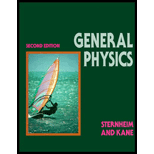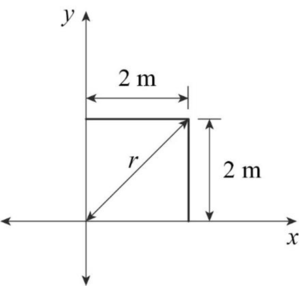
Concept explainers
(a)
The magnitude and direction of electric field at
(a)
Answer to Problem 66E
The magnitude of electric field at
Explanation of Solution
Given that the charge
Write the expression for the of electric field at a point due to a point charge.
Here,
Conclusion:
Substitute
The magnitude of electric field is,
The direction of electric field is radially outward from a positive charge and radially inward to a negative charge.
Since, the given charge is negative; the electric field will be towards the charge. The direction of electric field is towards negative
Therefore, the magnitude of electric field between the plates is
(b)
The magnitude and direction of electric field at
(b)
Answer to Problem 66E
The magnitude of electric field at
Explanation of Solution
Given that the charge
Write the expression for the electric field at a point due to a point charge.
Here,
Conclusion:
Substitute
The magnitude of electric field is,
The direction of electric field is radially outward from a positive charge and radially inward to a negative charge.
Since, the given charge is negative; the electric field will be towards the charge. The direction of electric field is towards positive
Therefore, the magnitude of electric field at
(c)
The magnitude and direction of electric field at
(c)
Answer to Problem 66E
The magnitude of electric field at
Explanation of Solution
Draw the figure for charge and the point.

From the figure, use Pythagoras theorem to calculate the distance of the point from the origin
Write the expression for the distance of the point from the charge,
Here,
Substitute
Given that the charge
Write the expression for the electric field at a point due to a point charge.
Here,
Conclusion:
Substitute
The magnitude of electric field is,
The direction of electric field is radially outward from a positive charge and radially inward to a negative charge.
Since, the given charge is negative; the electric field will be towards the charge from the point.
Therefore, the magnitude of electric field at
Want to see more full solutions like this?
Chapter 16 Solutions
General Physics, 2nd Edition
- A circular ring of charge of radius b has a total charge q uniformly distributed around it. Find the magnitude of the electric field in the center of the ring. (a) 0 (b) keq/b2 (c) keq2/b2 (d) keq2/b (e) None of these answers is correct.arrow_forwardA rod 14.0 cm long is uniformly charged and has a total charge of 22.0 C. Determine (a) the magnitude and (b) the direction of the electric field along the axis of the rod at a point 36.0 cm from its center.arrow_forwardIs it possible for a conducting sphere of radius 0.10 m to hold a charge of 4.0 C in air? The minimum field required to break down air and turn it into a conductor is 3.0 106 N/C.arrow_forward
- Three charged particles are located at the corners of an equilateral triangle as shown in Figure P19.9. Calculate the total electric force on the 7.00-C charge.arrow_forwardConsider a thin, spherical shell of radius 14.0 cm with a total charge of 32.0 C distributed uniformly on its surface. Find the electric field (a) 10.0 cm and (b) 20.0 cm from the center of the charge distribution.arrow_forwardTwo particles with charges q1 and q2 are separated by a distance d, and each exerts an electric force on the other with magnitude FE. a. In terms of these quantities, what separation distance would cause the magnitude of the electric force to be halved? b. In terms of these quantities, what separation distance would cause the magnitude of the electric force to be doubled?arrow_forward
- Consider the electric dipole shown in Figure P19.20. Show that the electric field at a distant point on the + x axis is Ex 4 keqa/x3.arrow_forwardCalculate the magnitude of the electric field 2.00 m from a point charge of 5.00 mC (such as found on the terminal of a Van de Graaff).arrow_forwardCalculate the work that must be done on charges brought from infinity to charge a spherical shell of radius R = 0.100 m to a total charge Q = 125 C.arrow_forward
- Sketch the electric field lines in the vicinity of the charged insulator in Figure 18.51 noting its nonuniform charge distribution. Figure 18.51 A charged insulating rod such as might be used in a classroom demonstration.arrow_forwardShow that the maximum magnitude Emax of the electric field along the axis of a uniformly charged ring occurs at x=a/2 (see Fig. 23.3) and has the value Q/(630a2). Figure 23.3 (Example 23.2) A uniformly charged ring of radius c. (a) The field at P on the x axis due to an element of charge dq. (b) The perpendicular component of the field at P due to segment 1 is canceled by the perpendicular component due to segment 2.arrow_forwardConsider the charge distribution shown in Active Figure 19.31. (i) What are the charges contributing to the total electric flux through surface S? (a) q1 only (b) q4 only (c) q2 and q3 (d) all four charges (e) none of the charges (ii) What are the charges contributing to the total electric field at a chosen point on the surface S? (a) q1 only (b) q4 only (c) q2 and q3 (d) all four charges (e) none of the charges Active Figure 19.31 The net electric flux through any closed surface depends only on the charge inside that surface. The net flux through surface S is ql/0, the net flux through surface S is (q2 + q3)/0, and the net flux through surface S is zero.arrow_forward
 Principles of Physics: A Calculus-Based TextPhysicsISBN:9781133104261Author:Raymond A. Serway, John W. JewettPublisher:Cengage Learning
Principles of Physics: A Calculus-Based TextPhysicsISBN:9781133104261Author:Raymond A. Serway, John W. JewettPublisher:Cengage Learning Physics for Scientists and Engineers: Foundations...PhysicsISBN:9781133939146Author:Katz, Debora M.Publisher:Cengage Learning
Physics for Scientists and Engineers: Foundations...PhysicsISBN:9781133939146Author:Katz, Debora M.Publisher:Cengage Learning College PhysicsPhysicsISBN:9781305952300Author:Raymond A. Serway, Chris VuillePublisher:Cengage Learning
College PhysicsPhysicsISBN:9781305952300Author:Raymond A. Serway, Chris VuillePublisher:Cengage Learning College PhysicsPhysicsISBN:9781285737027Author:Raymond A. Serway, Chris VuillePublisher:Cengage Learning
College PhysicsPhysicsISBN:9781285737027Author:Raymond A. Serway, Chris VuillePublisher:Cengage Learning
 College PhysicsPhysicsISBN:9781938168000Author:Paul Peter Urone, Roger HinrichsPublisher:OpenStax College
College PhysicsPhysicsISBN:9781938168000Author:Paul Peter Urone, Roger HinrichsPublisher:OpenStax College





